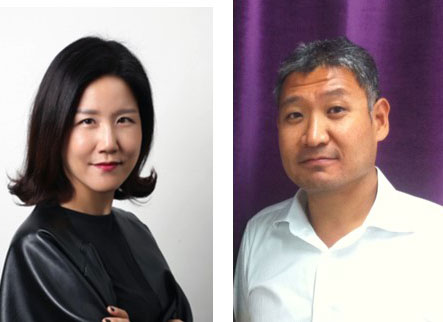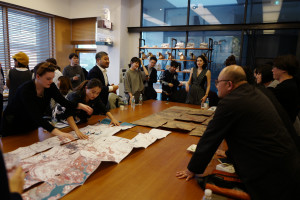Alumni Q&A: Jungyoon Kim MLA ’00 and Yoonjin Park MLA ’00 of PARKKIM
Jungyoon (Yuni) Kim MLA ’00 and Yoonjin Park MLA ’00 are Founding Principals of PARKKIM. This Spring, they are Design Critics in Landscape Architecture at the Harvard Graduate School of Design (GSD) co-teaching the option studio “Korea Remade: Alternative Nature, DMZ, and Hinterlands” with Professor Niall Kirkwood. The studio will advance alternative futures for a reunified Korean Peninsula through the concerns of ecology, technology, and design. The reunification of the two Koreas will occur in the next decade, and design work will address population displacement, redrawing of boundaries, new industrial development, and a reimagined role for the landscape and its future inhabitation.
They founded PARKKIM in 2004 upon winning the Chichi Earthquake Memorial International Competition. Previously, they worked at West8 in Rotterdam, the Netherlands and taught at Wageningen University and Research Centre in the Netherlands.Their book Alternative Nature (2016), is a compilation of their published articles. The term ‘alternative nature’ was first presented at their essay Gangnam Alternative Nature: the experience of nature without parks published in the book Asian Alterity (ed. William Lim, Singapore: 2007), rethinking the concept of ‘what is natural?’ within the context of contemporary East Asian urbanism.
Hear more about their practice, “Korea Remade,” and alumni engagement in this Alumni Q&A.
Tell us about your background. Where were you born?
Both: We both were born in Seoul Korea and raised mainly in the Gangnam area of Seoul, which is a relatively new and densely developed residential area. Jungyoon briefly lived in Cambridge when she was six years old thanks to her father’s study. After college education, we lived abroad for about ten years in the US and the Netherlands, so we were exposed to non-Korean culture for most of our mid 20’s to 30’s.
What previous degrees do you have?
JK: I got my Bachelor of Agriculture with landscape architecture major from Seoul National University.
YP: I received my Bachelor of Engineering and Master of Landscape Architecture at Seoul National University.
What is the most significant thing you learned while at the GSD?
JK: I learned that design is the process of logical thinking, not coming from my fingertips. It was the hardest thing to make it mine and took some time to get accustomed. But then it is obviously valid, from the very beginning of design process to the end of construction supervision, because we do need a consistent commonality with which we make everyday decisions.
YP: At that time, globalism at design field was emerging, and I was very excited to learn about it.
What is your favorite memory of the GSD?
JK: I was taught by Professor Peter Del Tredici (now Senior Research Scientist Emeritus) of Arnold Arboretum in the mandatory plant class. The class usually started about 8:30 am, which is too early for core studio students staying late at the studio. One day, the class met in the Boston Common on a chilly morning, and Del Tredici appeared with a huge bag of bagels. The bagel was cold but warmed me up.
YP: Seeing sunrise in the fourth tray of Gund Hall with studio buddies, after staying overnight.
4. Looking back, what experiences at the GSD were the most helpful in shaping your career (these can be seen broadly as courses, student activities, lectures, conferences, etc.)?
JK: People, including my clients, are caught by my Harvard degree in my resume at the beginning. But for me, my time at GSD is not something which ended at commencement. When looking back on my 14 years of practice, there were many crises to overcome. At every moment, the experience of conversation with ‘THE’ biggest designers of that time, of getting myself through those very direct and harsh critics, of attending conferences in Piper and of some of the successful reviews and pinups reassured my confidence and let me go forward.
YP: For me, it was individual talks with instructors and design critics, especially when we discussed our lives as designers.
5. About what design problems are you passionate?
JK: Limitation not only throws problems to us, but also gives us clues toward solutions. We both like to challenge the limitations imposed by site, budget, time, and clients. When our challenge succeeds, the design process and endeavor always yields quite fulfilling results.
YP: There are many ways to “love nature.” For designers, it is very important to evoke the multiplicity of nature rather than a singular understanding of it—I think this was how we came with the idea of ‘alternative nature.’
6. Who or what inspires you and your work?
Both: We don’t usually spend too much time to look at other designers’ works. Instead, the great source of inspiration is nature itself. We visited Yosemite National Park three times over last four years in different seasons, and the place always showed us totally different faces. We both also like physical exercise. Jungyoon runs at least 3-4 times a week and practices yoga at home. Yoonjin is an amateur yet serious sportsman. The time being away from the office and using my body (not brain) really inspires.
7. The concept of “Alternative Nature” within the context of contemporary East Asian urbanism has been a philosophy and methodology behind your practice. Can you share more about this guiding framework?
Both: It is basically about how we deal with the limitation and how we react to the context we are working with and live in Seoul Korea. We grew up in the Gangnam area where almost no urban parks exist, despite its high real estate value. After we came back from 10 years of living abroad, we started questioning—how are people able to survive without parks in such a dense urban condition? How they acquire the experience of nature without the help from parks? Then we found, instead of western notion of ‘middle landscape,’ there is the way of getting the experience of nature, and we started to call them ‘alternative nature.’
8. This semester (Spring 2018), you are co-teaching the option studio with Professor Niall Kirkwood “Korea Remade: Alternative Nature, DMZ, and Hinterlands” which will advance alternative futures for a reunified Korean Peninsula through the concerns of ecology, technology, and design. What are the central design challenges facing these locations? What sites did the studio trip visit?
Both: The DMZ (Demilitarized Zone) is at the center of the Korean Peninsula and has been dividing it into two parts since the armistice agreement in 1953. It is physically in the peninsula but politically overseen by the UN and international law. There have been many of interesting, imaginative proposals on the topical land, but most of them were thought out within the current boundary which is 2km to the North and the South from the military demarcation line.
The first challenge to our students was to re-territorize the DMZ and Hinterlands with 13 different themes including viewshed, watershed, geology, restoring tiger habitat, valley, landmines, inclination, renewable energy, and so forth. So let’s say, what if two Koreas agreed to open up some part of the current border and to start a dynamic exchange of people and goods? Then the new set of porous boundaries proposed by the studio can function as the spatial infrastructure for a new settlement. The students visited Korea including DMZ and Seoul and are now working on more detailed design within their own territories. While we were in Korea, we also tried to expose them to the essence of Korean Traditional culture, not just K Pop and K Beauty, but also some of the very high-end culture: For example, the Korea Furniture Museum and SungRokWon, which is the only private residence/garden of Joseon Dynasty remained in Seoul showing how a traditional Korean settlement and lifestyle existed within nature.

Jungyoon Kim MLA ’00 and Yoonjin Park MLA ’00 with students on the studio trip for “Korea Remade: Alternative Nature, DMZ, and Hinterlands”
9. What is the importance of students on studio trips connecting with local alumni? I understand that this is a component of the studio trip in South Korea.
Both: There was an alumni forum held on March 24, not only just to welcome the studio but also to exchange the works and ideas of the studio and alumni mutually. There are more than 200 GSD alumni in Korea, both practitioners and educators, and it was a bilateral beneficial event for both students and alumni. There were also some of the non-alumni attendees including Min Cho (who won the Golden Lion at 2014 Venice Biennale with the exhibition on North Korea), Doojin Hwang (Architectural Advisor of Kaesung Industrial Complex) and even some of the government officials related the reunification. Five speakers (three alumni and two guests) presented about their work and research on DMZ and North Korea first, and then students shared their works. There were also very active Q&A and discussion. The event broadened up the perspective of students.
10. How has the GSD changed since you were students?
Both: The number of students has doubled. There is more interaction with the University outside of GSD, having Homi Bahbah, the Anne F. Rothenberg Professor of the Humanities at Harvard University, and Chicago Mayor Rahm Emanuel for example, and the voice of students got stronger. And I love the book scanner at Loeb.
11. Yoonjin, you have been named as the incoming President of GSD Korea. What is your vision for this organization? Why should alumni in Korea engage with this group?
YP: My vision is to initiate events of intellectual activity such as “GSD FORUM’ at least twice a year. The one we had this month with the “Korea Remade” studio was the first example. Another objective is to make common ground not only within the GSD alumni but also for the student organization KoreaGSD. By participating in this group, alumni in Korea can contribute to the GSD through various ways.
12. Tell us about your work/life balance? What occupies you when you are not working?
JK: We are work partners and more importantly husband and wife with a daughter together. So there is no such thing as ‘work/life balance’ for us. Life has been work. It is not always easy to maintain both the office PARKKIM and family PARKKIM simultaneously at the level we are aiming. But then, we also try to challenge that limitation as well to yield the best result. Other than my time at the office, time with my daughter Jane and our puppy Marie is the most valuable. And we exercise a lot.
What advice do you have for GSD students and/or alumni?
JK: For the students, I would like to share what was lacking when I was in their position–please take advantage of Harvard’s great resources. I have to confess that I’ve never been to the gorgeous Widener’s study room and Harvard–Yenching Library when I was a student. I was just so occupied with the studio mentally. But the more you engage with all the opportunity and resources that the School offers every day, the more you will build up your capacity as a designer.
13. What are you working on today?
Both: In our office, we have several projects in progress including the campus for Hyundai Motors, a civic plaza within Seoul Region, and invited competition entries. Also, we are preparing for a few of design-build projects. Along with the design works, Jungyoon is preparing the lecture at UNSW in Sydney this coming May on Alternative Nature, with a slightly different presentation structure than previous lectures we had, including some contents of the “Korea Remade” studio.



